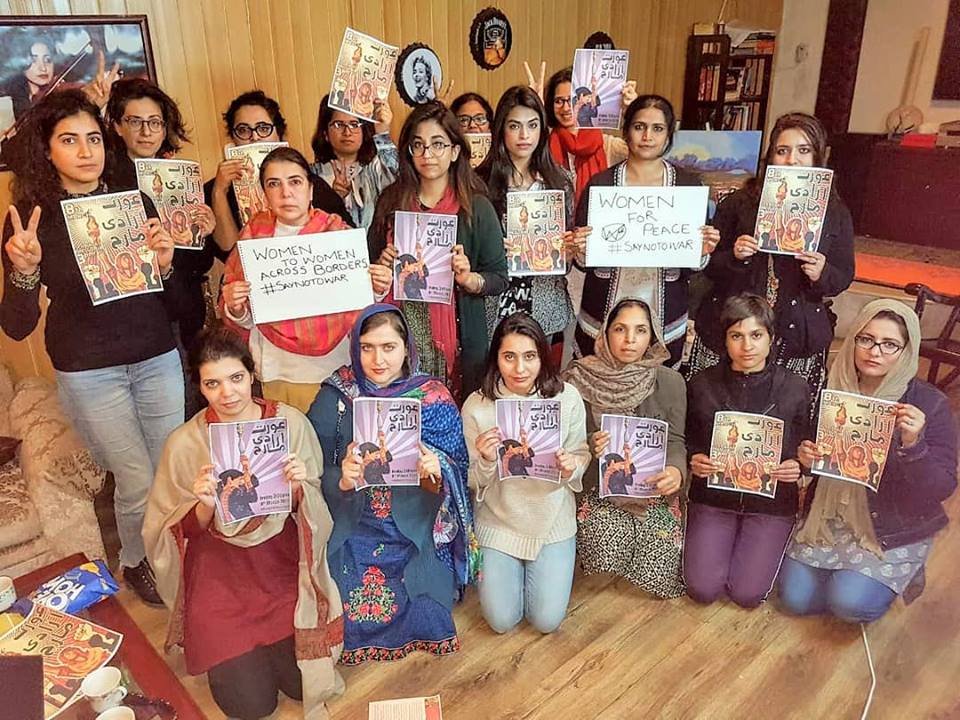
Tooba Syed
 MARCH 8, 2019, will be remembered as a day of hope and unabashed protest, in which thousands of women in Karachi, Lahore, Islamabad, Hyderabad, Quetta, Peshawar, Gilgit-Baltistan and Mardan took to the streets and marched. Aurat March and other women’s marches reflected the collective consciousness of Pakistani women coming together organically and wilfully to march against deeply entrenched social and economic inequalities. We wielded signs of protest — chanted azadi — and threatened the entire patriarchal order.
MARCH 8, 2019, will be remembered as a day of hope and unabashed protest, in which thousands of women in Karachi, Lahore, Islamabad, Hyderabad, Quetta, Peshawar, Gilgit-Baltistan and Mardan took to the streets and marched. Aurat March and other women’s marches reflected the collective consciousness of Pakistani women coming together organically and wilfully to march against deeply entrenched social and economic inequalities. We wielded signs of protest — chanted azadi — and threatened the entire patriarchal order.
Read: Let me womansplain the Aurat March to you
In the days since International Women’s Day was commemorated, prominent male politicians, former bureaucrats and TV personalities have taken to social media, television and even the Sindh Assembly to cast aspersions and allegations, hurl threats and invective, against Aurat March, its organisers and participants. In the days since, countless women have been the recipients of death and rape threats on- and offline.
What prompted this backlash? March 8 last week represented the beginning of a new feminist movement, continuing the existing work of older feminists but starkly different too. It is, perhaps, the first time Pakistani women have spoken out as a movement about the social relations we share in society, and its embedded gender inequalities — especially within the private realm. This has obviously rattled the hegemonic stranglehold on society enjoyed by anti-women forces.
The backlash against Aurat March is evidence of its success as an existential threat to an exploitative status quo.
After decades of a lack of feminist mass resistance, a diverse group of women organised for a cause that is truly ours — no longer only making demands on the state, but also questioning the nature of exploitative relationships that form, undergird and define our lives. We are demanding justice, reforms from the state as well as our prevailing social, political, religious and economic systems.

The intense post-march backlash has been driven in particular by conservative right-wing political parties who weaponise religion for their myopic political agendas. There is a generalised, uninformed criticism directed against the notion of women on thestreets, outside the ‘domestic sphere’. Benefactors of a status quo that relegates women to the home to uphold gender segregation norms and prevent their participation in public life have lashed out with pernicious and pervasive force against several placards women carried at their marches.
The Pakistani woman: Where does she stand and where is she going?
Among the signs considered most ‘objectionable’ were those that challenged social relations inside the private sphere: the unequal domestic division of work and other exploitations of women’s labour. These messages have pushed the feminist movement to think critically about the unpaid care-work and social reproduction central to our economic and social system, especially the capitalist patriarchy. The placards also symbolised the intergenerational trauma and suffering(s) of women, debunking the claim that women are not conscious of our own oppression, often cited to understand the lack of a countrywide feminist movement.
Should feminists claim Aurat March’s ‘vulgar’ posters? Yes, absolutely
Much of the antipathy towards Aurat March can be explained by feminist scholar Rubina Saigol’s posit that, while men protect the territorial borders of a nation state, women are the protectors of its cultural borderlands. Women’s loud, unapologetic refusal to allow their bodies to be treated as reproductive vessels threatens not only patriarchy but the state, which relies on this reproductive labour to provide the nation with its ‘valiant soldiers’ and ‘willing daughters’. This powerful attempt to reclaim control over bodily autonomy is being termed as a rebellion against ‘cultural norms’, but who constructed them to begin with?
Overwhelmingly, the backlash is evidence of the immense success of the marches to pose an existential threat to patriarchal forces within the country. The criticism, oft-repeated by right-wing men and establishment feminists, is essentially one of how younger feminists have indicted the cultural fabric that has been weaponised to subordinate and subjugate us. This dismissal is a policing tool to shame women back into ‘traditional’ roles. The incessant need to silence such women goes to show how we as a society are forever in search of that elusive perfect victim to empathise with — a meek woman who asks politely and acquiesces easily.
Also read: Women on bikes have right of way in Pakistan. But only if they are white
Another attempt to delegitimise the marches is to label them ‘elitist’, despite the incredibly diversity in religious, class and ethnic composition, and active participation from katchi abadiresidents, informal-sector workers, domestic workers, lawyers, nurses, transgender women, non-binary folk and college students.
It has been particularly interesting to witness bourgeoisie men engage in an entirely selective class critique when it comes to women — an intellectual inconsistency that has never been more transparent. The critique is particularly insincere because it puts the entire burden of working-class representation on the shoulders of middle-class women organisers instead of having a nuanced debate about concerted efforts to weaken the left from the country’s wider political spectrum. Then there is the claim that the marches did not address ‘real’ issues, which is far from true given the exhaustive manifestos and literature produced by organisers calling for structural changes in the current political, economic, environmental and social order.
These criticisms are mere distractions, fear tactics by self-appointed representatives of the people. A week after the marches, women fought back against such harassment and intimidation on social media, with #IAmAMarcher trending in Pakistan. It appears clear that this movement, with all its imperfections and challenges, will continue to grow in coming years.
Also read:https://www.dawn.com/news/1469815/should-feminists-claim-aurat-marchs-vulgar-posters-yes-absolutely
Yet movement building requires not only critical mass, but also continuous organising and strategy that is not merely event-based. There is much that the progressive left can learn from this growing movement, such as internal ideological clarity, the will to mobilise, and openness towards new and creative ways of organising. Now, more than ever, progressive forces and resistance movements in the country need to assert women’s right to dissent, and to strengthen their struggles against deeply entrenched injustices and inequalities of gender, class, caste and ethnicity.
The feminist movement has clearly demonstrated the willingness of possible solidarities by including and emphasising demands for low-cost housing, a living wage, universal health and education, and an end to enforced evictions and displacements. One maintains the bleak hope that men might move past their knee-jerk hysterics and histrionics to engage with such demands.
The writer is a member of the Women Democratic Front and an organiser of the Islamabad march. She is also visiting faculty at Quaid-i-Azam University, Islamabad.
Twitter: @Tooba_Sd
Published in Dawn, March 18th, 2019

The High Asia Herald is a member of High Asia Media Group — a window to High Asia and Central Asia







